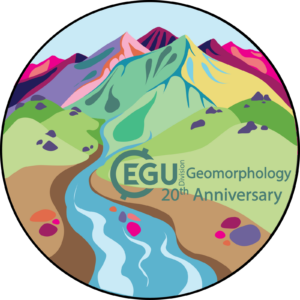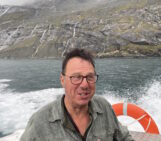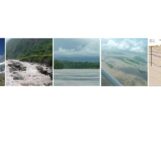![20 Years of GM [Part 1]: Looking Back with Geomorphology Division Presidents!](https://blogs.egu.eu/divisions/gm/files/2025/04/4-700x400.png)
This year the EGU Geomorphology (GM) division celebrates its 20th year (and it’s been a little over 10 years since our first GM blog post too!), so keep an eye out for exciting celebrations during the General Assembly in April. Ahead of this momentous celebration, we found time to sit down with four of the GM’s past presidents to discuss how EGU, the GM Division and the geomorphology community has progressed in those two decades. Read and watch below for some insights and clips from the interview with Niels Hovius (GFZ Potsdam), Andreas Lang (University of Salzburg), Peter van der Beek (University of Potsdam) and Daniel Parsons (Loughborough University). Also check out our companion piece on the 20th year of EGU-GM to hear from GM’s founder and first president, Colin Stark, and GM’s current division president, Kristen Cook.
The Inception of a New Division
We started the interview by asking how past presidents first got involved in EGU, and how they became presidents. Niels and Andreas fondly recalled the first and last joint meeting of the European Union of Geosciences (EUG) and the European Geophysical Society (EGS), in Nice in 2003. Over 12,000 people had registered to attend.
…[the conference] was horribly cramped, so it showed the real potential of bringing the geological and the geophysical communities together. – Niels
It is hard to believe that was little over 20 years ago! The Geomorphology Division of EGU, nor the equivalent within AGU, did not exist at that time, yet we have a flourishing GM community today. Creating the division required a lot of coordination and hard work.
…Geomorphology was subsumed in hydrology or hidden within programmes and I had a friend and research colleague, Colin Stark, who was in touch a lot with the then President of the Natural Hazards Division, Fausto Guzzetti. Fausto actually encouraged us to think about new divisions, the EGU was building and wanted to diversify and wanted to be a platform for the Earth Sciences in the broadest sense and it’s very important to acknowledge the role that Fausto as a non-Geomorphologist actually played in the inception of of the geomorphology division. – Niels
After Fausto Guzzetti, Colin Stark and Niels Hovius set up the GM Division and Niels had run it for a few years, Andreas Lang stepped up.
It was the place to do things, to change things, to bring in innovation …. Niels was really putting the first structures in, then I came in a bit from the side from the climate division originally, and they already had student poster awards, so I suggested why don’t we in geomorphology have student poster awards too? … and that basically was it. I was roped in, hooked up and off I went… and this is also how he roped me into standing as the next president. – Andreas
The bottom-up structure of EGU and the appreciation of early-career researchers, for example with the ability to suggest and convene sessions as an early career scientist and break norms at the time, and the ability to shape division policy, appeared to be a core aspect of why and how our previous presidents got involved.
… that was for me the big thing, because EGU allowed you to create your own session, just find a couple of like minded people and then off you go, and this was proper bottom up at the time…. and it was all different in experience from all the geomorphology and geology congresses that I experienced on a national level. – Peter
Our Strength in Valuing Community Voices and the Next Generations
A thread that came up time and time again in our chat was the desire of each of the presidents to deliver a community-focused GM Division that valued new perspectives as highly as tradition, and strong acknowledgement and support of early career researchers as the next generation of geomorphologists.
I’m really proud that the geomorphology division started at that particular point as a bottom up initiative without that notion of hierarchy and with a healthy irreverence in the direction of established protocol. We created a prize for geomorphology, but we wanted that not to be an end-career prize but a mid-career prize, and that was one of the very first [divisions] in the Union to do that. We developed a number of initiatives that were breaking the mould, and I think that is a tradition that is strong within the geomorphology division and you do see it alive and kicking today. – Niels
…from the growth of the division, you can see that it’s not just Niels and myself and a handful of others, but this is really a community effort and is in a super healthy state now. – Andreas
...Niels you had started the Penck Lecture, which was really nice. It was the early career scientist awardee of the Geomorphology Division, who would get a full lunchtime block lecture, and there were some memorable ones I must say, and I always really enjoyed them. – Peter
I do think that the bottom up approach does empower people who are not necessarily empowered by their home systems and you do see that people rise to prominence within the Union, that in their home system don’t get the chances that they deserve. – Niels
[During the COVID-19 Pandemic]…we were able to augment and support from EGU really showed that togetherness of the geomorphology community at its real best, through the coordination that EGU provides loosely. That really demonstrated for me how well that community had been created and curated by the people on the call here over a number of years. – Daniel
Turning Challenges into Opportunities and Milestones
When we asked about challenges each of the presidents faced, and any particular milestones, they all managed to speak about the opportunities for progress and change that came about.
I think it [the Earth Surface Dynamics journal] was a massively important step for the geomorphology division and for the geomorphology community. – Niels
… [the Earth Surface Dynamics journal] was the exciting point after the division was established and it shows how EGU is an enabler, how it allows you to do things. I mean it didn’t come out of the blue. This was us wanting to have an outlet that is open science, that is non for profit, that has a public peer review and yes EGU allowed us to do it. Yes, we had to climb up some hills to get there but it wasn’t too rough a ride… – Andreas
I felt there was still lots and lots of work for us to do on the equality, diversity and inclusion front as an entire EGU, not just as a division. So, I took that role really seriously in terms of also serving on the EDI committee and looking at our medals and award processes: what we value, how we value it, how different types of diversity was included in different parts of the programme. And looking at a range of innovations in those spaces that colleagues across EGU led on. But I was forthright in my support of those, because I felt that if EGU was going to succeed as well as it could, it needed to do some work around the the EDI agenda, and I was pleased that of the progress that was made and has continued to be made by a range of colleagues in that space. – Daniel
Future Challenges…
Past and present challenges covered, with all due celebration for the progress made, we acknowledge that there are still things to overcome – What do the previous presidents think the geomorphology division, geoscience community, and broader scientific community will face in the next decades to century?
Decarbonisation and the rise of AI. We can’t possibly imagine, I certainly can’t, the impacts of those two things over the next decade… I think the innovations that are going to come from these will mean that it has the potential of really revolutionising science and how science is done. And so being bottom driven and steered in many ways as an organisation, I think there’s a real challenge for the forthcoming leadership of GM and EGU more broadly to make sure that we’re harnessing the opportunities in the most ethical ways that we need to, and making sure that we’re ahead of the curve of those opportunities as well, so that we’re leading rather than following. Big, but I think that’s where the real innovations are going to be. – Daniel
…[Niels] did think ways into other communities that are not the scientists but professionals, teachers and so on. So that was really also important for the Union and now with Peter at the helm, I mean that continued and I think this is an impact that puts geomorphology far beyond other divisions. We are not just shaping the things that we do, we shape the Union and that I feel is a good thing. Let’s continue to do so and hopefully the young generation here can follow those footsteps. – Andreas
For me there is a major field of tension between people and landscapes or natural systems. … we live in a world that increasingly is losing the last bits of real nature, real wilderness and little patches of true virgin Geomorphic terrain… The earth surface on which we live is shared between natural processes and socioeconomic processes and drivers, and that multifunctionality of that surface has to be acknowledged and has to be protected.
Geomorphology plays a very important role in defining actually, which are the natural dynamics that have to be safeguarded in order for the socioeconomic activity and processes to in turn be safe and to be sustainable. So that sustainable partnership of nature and people at the earth’s surface is, I think, squarely within the remit of geomorphology, at least to contribute. – Niels
… there’s been one specific focus in that Science for Policy Working Group, which was on biodiversity, and the second one is being set up now and it is going to be on resilience to climate related hazards and both of these have very clear links to Geomorphology, obviously. And therefore, for the discipline, realising that there are policy related questions and that we can actually inform policies is a really important step to take, I think. And so getting involved in that kind of work and that kind of outreach is also a very important step that the discipline and that the community could and should take, I think. – Peter
… and Advice for the Future
We couldn’t just end on the serious notes! The geoscience community has translated many past challenges into opportunities, and this 20th year is a celebration of that within geomorphology. What advice do the presidents want to pass on to current and future generations?
… [Geomorphology] has a dynamic that encourages and draws in new generations of people. That’s very important because in many other disciplines within natural science, when these disciplines mature they go off the boil and they stop attracting exciting people. So if you think it’s a young field then that means it’s alive and that’s good. – Niels
I’ve made so many friends and colleagues and networks through EGU that I can’t begin to describe how much warmth and how much opportunity has been afforded to me from working around incredible people. And that’s been brought together by EGU. Enjoy it and embrace the opportunity it provides. – Daniel
… [EGU] is a bottom up, volunteer led organisation and that also means that things are possible if you have good ideas, you can convince people of these ideas and and you will get the opportunity to put them in practice, and so that just means get involved and talk to people and do something: convene sessions, become a science officer, and go into the committees as well. There’s so many things to do and we, EGU, welcome volunteers because there is so much to do. In a broader sense, I do think, at least personally, I realise that things are more challenging now, probably than they were 20 years ago when we were at this stage, and so it’s hard to say – to give advice and to say how great this all is. But it is true it is a fantastic career, and it is worth trying to make it in that career. – Peter
It’s Fun. That’s probably the most important part there, and for me it has been fun all those years from the start, and if you can get that message across to the next generation, I think then you are in a good position as a division, as a community, as a Union. But yes, we were the lucky ones…. Get out there, do outreach and help convince people that the world is a great place to live, if we just take care. – Andreas


![20 Years of GM [Part 2]: A conversation on change and progress with Geomorphology’s first and current presidents](https://blogs.egu.eu/divisions/gm/files/2025/04/GM-20th-anniv-banner-9-161x141.png)

